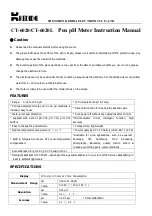
Brookfield Engineering Labs., Inc.
Page 86
Manual No. M13-167-A0415
VII.4 The Casson Model
√h
D
√τ = √τ
o
+
(
τ
= shear stress,
τ
o
= yield stress,
h
= plastic viscosity, and
D
= shear rate)
What does it tell you?
The Casson model provides parameters similar to that of the Bingham model. However, unlike
the Bingham model, it was developed for materials that exhibit non-Newtonian flow after yielding.
The Casson model indicates the product’s yield stress (
τ
o
) which is the amount of shear stress
required to initiate flow, and the product’s plastic viscosity,
h
, which is the viscosity of the product
after it yields.
Figure VII-4
When should you use it?
The Casson model should be used with non-Newtonian materials that have a yield stress and that
do not exhibit a “Newtonian-like” behavior once they begin to flow. This model is most suitable
for fluids that exhibit Pseudoplastic or shear thinning, flow behavior after yielding.
These fluids have a non-linear flow curve. The point at which it crosses the y-axis is the product’s
yield stress (
τ
o
). To protect the point at which the curve will intersect with the y-axis, the Casson
model linearizes or straightens the plot by taking the square root of the data. To ensure accurate
extrapolation to yield stress it is best to take some data at low shear rates.
Summary of Contents for DV3T
Page 2: ......
















































